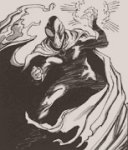Upon reviewing D3, daemons don't appear to have been used as guards or for any practical purpose whatsoever in that module. The only place I could find them in the module is on the random encounter table for the city of Erelhei-Cinlu, where they appear to be visitors. They seem to have been put there for no other reason than to reinforce the cosmopolitan character of the city, but a strained reading could tie their presence to the conflict between the city's leading houses. The houses loyal to Lolth may have a stronger connection to demons than those who have converted to the worship of the Elder Elemental God. I say this because one of the former houses (Despana) has among its magic possessions a demon staff while one of the latter houses (Tormtor) has a scroll of protection from demons. So it could be that certain daemons have been enlisted on behalf of the latter houses to counter any demonic aid that may be available to the former. It's also likely, however, that Gygax was looking for a location to place the newly created monsters and found the city's random encounter matrix suitable for the purpose.
I think that another possibility (which was suggested to me by the details you've gone and dug out) is that Gygax wanted to place some creatures that might trigger some players to attempt anti-demon magic, but which are not technically demons. It's another opportunity for "skilled play".
Maybe I overstated the mezzodaemon's dislike for rules in my paraphrase of the passage from D3, given that the original statement was made about the "strict" rules of devils, to whom the mezzodaemons are not otherwise averse. It is said daemons will enter into compacts with other evil creatures as long as the arrangement is beneficial to themselves. To make a distinction between that and the CE behavior expected from demons and the like, I'd say that while NE creatures will freely accept such compacts, CE creatures will only accept them under threat of coercive force. Otherwise, CE creatures will not submit to any such entanglements on the principal that they limit the power of the individual in favor of the group as a whole.
I can follow your reasoning, but personally I can't really get on board with it. Ogres are pretty much paradigms of CE, for instance, but they cheerfully work with (LE) orcs.
The PHB and DMG tell us that
The major precepts of [CE} are freedom, randomness, and woe. Laws and order, kindness, and good deeds are disdained. life has no value. By promoting chaos and evil, those of this alignment hope to bring themselves to positions of power, glory, and prestige in a system ruled by individual caprice and their own whims.
The chaotic evil creature holds that individual freedom and choice is important, and that other individuals and their freedoms are unimportant if they cannot be held by the individuals through their own strength and merit. Thus, law and order tends to promote not individuals but groups, and groups suppress individual volition and success.
There is nothing here that precludes entering into a compact if it promotes the wellbeing of the CE creature. Of course it will betray the compact if that suits it, but then so will a NE creature, I think:
The neutral evil creature views law and chaos as unnecessary considerations, for pure evil is all-in-all. Either might be used, but both are disdained as foolish clutter useless in eventually bringing maximum evilness to the world.
[N]eutral evil holds that neither groups nor individuals hove great meaning. This ethos holds that seeking to promote weal for all actually brings woe to the truly deserving. Natural forces which are meont to cull out the weak and stupid are artificially suppressed by so-called good, and the fittest are wrongfully held back, so whatever means are expedient can be used by the powerful to gain and maintain their dominance, without concern for anything.
Given that a neutral evil being acts "without concern for anything" but gaining power and maintaining dominance, and will use "whatever means are expedient", I think a NE being likewise will betray a compact if that is to its benefit.
I also find the difference between "the powerful gain[ing] and maintain[ing] their dominance" (NE) and "bring[ing] themselves to positions of power, glory, and prestige in a system ruled by individual caprice and their own whims" (CE) fairly hard to make out.




